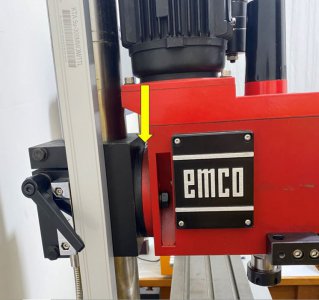My Emco FB2 mill is out-of-tram along the Y axis by 0.05 mm over a distance of 150mm and I am planning to make a wedge shim between the head and the vertical slide block ( if that's the correct term ) to correct it. The photo shows the location of the shim.
I have already got some idea on how to machine the shime but how can I check whether the shim is in good contact with the metal surfaces on both sides ? The head is secured to the slide block only by two bolts, one on each side. It is possible that the shim is not machined well leaving gaps on the upper or lower sides. That can severly affect the rigidity.
I am thinking about using engineering blue but I will not be able to rotate the head like sliding a piece of metal being checked over a flat reference surface because once the bolts are loosen, the weight of the head will tilt it. Will it be sufficient to just tighten the bolts and then take it apart to check the colorization of the contact surfaces ? Will appreciate some advices.
I have already got some idea on how to machine the shime but how can I check whether the shim is in good contact with the metal surfaces on both sides ? The head is secured to the slide block only by two bolts, one on each side. It is possible that the shim is not machined well leaving gaps on the upper or lower sides. That can severly affect the rigidity.
I am thinking about using engineering blue but I will not be able to rotate the head like sliding a piece of metal being checked over a flat reference surface because once the bolts are loosen, the weight of the head will tilt it. Will it be sufficient to just tighten the bolts and then take it apart to check the colorization of the contact surfaces ? Will appreciate some advices.


